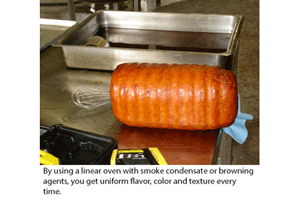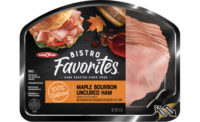The centuries-old process of smoking meat has taken a new turn. Instead of using the customary smokehouse to preserve and enhance the flavor of meats, food processors in many regions of the world are integrating the smoking and browning into inline cooking that not only simplifies a laborious process, but also delivers significant health and competitive advantages.
processors in many regions of the world are integrating the smoking and browning into inline cooking that not only simplifies a laborious process, but also delivers significant health and competitive advantages.
The use of smoke condensate (aka “liquid smoke”) in combination with automated pasteurization equipment such as an inline infrared pasteurizing tunnel provides manufacturers of smoked products such as deli meats with significant process and product benefits, while eliminating many of the unwanted side effects of the traditional smokehouse method.
Wood condensates have been produced for more than 50 years by condensing the vapors in “smoked” water made by cooking charcoal and the chips of sawdust of various species of wood. Condensates have three major components—acids for smoking; phenols for flavor; carbonyls for browning, or achieving a “smoked” color. By manipulating those components as well as the type of wood and cooking process, manufacturers that smoke with condensates are able to deliver the exact taste and appearance specified by the customer.
Yet, while many meat processors are reaping the benefits of the condensate smoking technology, in parts of Europe, they still cling to the traditional smokehouse process, either because of indiscernible regulatory perspectives or as a result of waiting for others to adopt new technology first.
Simplifying the process
“If I told you that you can smoke a ham or other meat product in a minute instead of hours, you would probably be compelled to take a look at the quicker process,” says Chris Gutman, managing director of Red Arrow International, a Manitowoc, Wis.-based producer of smoke condensates.
Unitherm Food Systems, a Bristow, Okla.-based leader in food processing equipment, was one of the first companies to integrate smoking and browning condensates with the cooking of meat products. An example is the incorporation of a smoke condensate drench system at the in feed of its infrared pasteurizer, an inline smoking process that provides a quick surface treatment to pre-cooked products to naturally eliminate bacteria and increase shelf life by 30-50%.
“After the product is cooked and chilled, the condensate is applied to the outside of the meat, which then continues through the infrared pasteurizer for about a 60-second dwell time,” says Adam Cowherd, vice president of international sales for Unitherm. “In addition to achieving the smoking and some surface texturizing, surface heat applied by the pasteurizer causes a Maillard reaction for the browning. So, after about a minute, instead of hours, the product can be retail packaged with no further post-packaging pasteurization required.”
Cowherd adds that by smoking inline, manufacturers eliminate the lengthy smokehouse process, which can increase plant capacity by 30%.
The use of the smoke condensate in combination with the infrared pasteurization has paid great dividends for CIAL Alimentos, a major processor of sausage, turkey and ham products located in Pudahuel, Santiago, Chile.
“Our plant updated its smoking process, previously utilizing smoked wood, to greatly improve on the smoking time and throughput while eliminating the risk of fire and reducing air pollution,” says Gerardo Zuccarelli Offermanns, assistant process manager.
He adds that the firm, which produces approximately 35 tons of smoked turkey and pork products per day, now smokes those products at a rate of 29 items per minute through two Unitherm IR tunnels, instead of taking 2-5 hours using the traditional wood burning process.
“The system is very flexible,” Gerardo says. “Using this system, I can now smoke different products at the same time.”
The automated smoke condensate method also pays off in terms of yield loss. According to Unitherm’s experience, the typical yield loss using the traditional smoking process is between 9-12%. Because of low process residence time, inline smoking using condensates results in a yield loss of only about 2%.
Enhancing the product
Inline smoking with condensates also creates genuine flavor and appearance with greater uniformity. A variety of condensates are available, such as popular species like mesquite, hickory, maple and fruitwoods, plus customer-tailored flavors.
“Uniformity of taste and color is very noticeable,” says Gutman. “When you are using the traditional smokehouse process, you can often see inconsistencies in color, where one part of a product is slightly lighter or darker than the rest, which would also mean differences in flavor. By using a linear oven with smoke condensate or browning agents, you get uniform flavor, color and texture every time.”
Another important improvement is a healthier product. Traditional smoking exposes meats to contaminants that are viewed as potentially harmful. The tars that are present in smokehouse vapors include PAHs (polycyclic aromatic hydrocarbons), substances associated with the risk of gastrointestinal cancer. Processing of smoke condensates involves removing tars and other potentially harmful contaminates from the smoke. When used in combination with an inline oven such as Unitherm’s infrared system, tests have shown at least 3-log reduction in lysteria and other pathogens.
EU misconceptions
Smoking with condensate has reached broad acceptance worldwide. In the United States for example, more than 85% of smoked turkey products are produced via this process. The USDA and FSIS recognize the process as a post-lethality treatment on deli meat. Food processors that have adopted this process move from an alternative-3 classification to an alternative-2, or from an alternative-2 to an alternative-1 classification as recognized by USDA and FSIS.
“The lag in embracing this smoking technology is noticeable in the EU,” says Bartosz Psiuch, a partner with European food technology importer/exporter, Alimp. “One possibility is that in some regions the smoke condensate process may be confused with smoke flavoring. But that is not the case. And if manufacturers would compare the liquid smoke process with the traditional smokehouse approach, it would prove to be much cleaner and also offers many productivity benefits.”
Psiuch notes that smoking with condensate is safer because it is carcinogenic-free, as opposed to smokehouse smoke. He adds that smoking and browning with condensates has caught on in some emerging European markets where food processors are more competitive, are seeking improved profitability and don’t want to be left behind.
“There are more progressive processors in Poland, for example,” he says, “where the condensate smoking process is becoming popular because the technology is already very successful. Also, there are no regulations against the process there and in Greece and other dynamic emerging markets, including South America.”
“When regulatory agencies such as the European Food Safety Authority (EFSA) categorized smoke condensates as flavors, it gave rise to questions about the use of smoke condensates as a process,” says Gutman. “In Europe at the regulatory level, we have been stuck with the misconception for years that our products are used only to impart a flavor. However, thousands of Red Arrow customers in Europe and around the world realize that the greatest use of smoke condensate is for the replacement of traditional smoking processes to give color, texture, taste and microbial control in an economical package.”
A statement from LACORS, the UK’s Local Authorities Coordinators of Regulatory Services seems to support Gutman’s position: LACORS view is that hot smoking and cold smoking (i.e. using smoke condensates that are atomized and applied to foods) are virtually the same. Therefore, there is no need to include them in a list of ingredients, and it would also be acceptable to describe foods treated this way as “traditional” or “natural.”
To help ensure a better understanding of the condensate smoking process and the many potential benefits for European producers, Unitherm opened a new solutions center near London where food processors can visit and test the inline smoking and browning process on the meat products of their choice.



